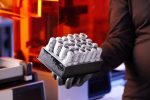3DPRINTINGINDUSTRY.COM
New resin and curing system aimed at injection molding performance by Formlabs
Formlabs, a Massachusetts-based developer of professional SLA and SLS 3D printers, has announced two upgrades to its stereolithography ecosystem: a second-generation Form Cure post-curing unit and a new formulation of its Tough 1500 Resin. The company states these additions bring 3D printed parts closer to the mechanical durability of injection molded components while accelerating production workflows. Tough 1500 Resin V2 offers 10 times the fracture toughness and three times the Gardner impact strength of its predecessor, with elongation at break exceeding 150%. These enhancements allow parts to better resist cracking or shattering under mechanical stress. According to Formlabs, the new formulation now compares to polypropylene, a widely used injection molding material. For 3D printing to compete with injection molding it needs to take a massive step in terms of material properties, said Max Lobovsky, CEO and co-founder. With our new Tough 1500 Resin, we have made a massive step change that brings us significantly closer to having 3D printed parts compete with injection molded parts in terms of toughness and longevity, but with much more design freedom and production flexibility.The new resin follows the companys earlier 2023 hardware release of the Form 4 and Form 4L SLA printers, which were designed to reduce part cost and increase printing speed. The current material update addresses the remaining performance gap between 3D printed and molded parts in terms of durability and long-term mechanical performance. Formlabs also introduced the second-generation Form Cure unit that reaches 60C in 60 seconds and enables post-curing of general-purpose resins in one minute. Engineering-grade resins require less than 15 minutes. Compared to the original Form Cure, these improvements reduce post-processing time by a factor of two to eight, depending on the material.This hardware has already been adopted by companies focused on high-throughput applications. Pairing the new Cure with Form 4, we can do so much more with fewer units, said Robert Mackowiak, Associate Rapid Prototyping Engineer at Hasbro. Matthias Krabel, Managing Director of German manufacturing company MAKRA PRO, noted the operational impact: If we do this with our old Cure, we need more Cures to cure all those parts, meaning more time for us and more hours we need to pay, so the Cure (2nd Generation) process is better for us cheaper and more efficient.Tough 1500 Resin V2 parts printed for functional prototyping and end-use. Photo via Formlabs.Alongside hardware and material improvements, Formlabs introduced new features in both its online Dashboard and desktop-based PreForm software platforms. Dashboard now includes Group Queues for automated print assignment and Cloud Slicing for faster remote job processing, aimed at teams managing multiple printers simultaneously.PreForms latest version adds seven language optionsEnglish, German, Spanish, French, Italian, Japanese, and Chineseand several workflow enhancements for high-volume users. These include model grouping, bulk model import, and Add to a Running Job for selective laser sintering (SLS) printers. These updates are intended to improve efficiency for dental labs, service bureaus, and other facilities managing large print queues.With these additions, Formlabs continues to position itself as a provider of 3D printing systems aimed at both prototyping and production. The companys product line includes SLA and SLS printers, more than 45 printing materials, and a growing set of tools for managing post-processing and fleet coordination.Electrical connectors printed in Flame Retardant Resin using Form 4 and Form Cure (2nd Gen), achieving up to 6x faster production. Photo via Formlabs.Advances in UV-Cured Resin Durability and Post-Processing AccessibilityRecent durability testing conducted on UV-cured resins has shown their potential to compete with engineering thermoplastics in industrial conditions. Henkel, a multinational chemicals and materials company, recently conducted a comparative study through its Loctite 3D Printing division to evaluate how UV-cured resins measure up against common injection molding thermoplastics. The testing focused on Loctite 3D 3843 BK and Loctite 3D IND403 BK resins and benchmarked them against PA6 and POM. Test procedures included accelerated weathering, heat aging, chemical immersion, and mechanical stress across varying temperatures. In parallel, PolySpectra, a California-based resin materials manufacturer, has introduced COR Zero, a cyclic olefin resin designed to bring industrial-grade material properties to desktop digital light processing (DLP) and liquid crystal display (LCD) 3D printers. This resin delivers a tensile strength of 53 MPa, a modulus of 2175 MPa, and elongation at break of 18%. Its impact resistance measures 400 J/m (un-notched) and 27 J/m (notched), with a thermal glass transition range between 125C and 145C. COR Zero can be post-processed using basic equipment including a freezer and a microwave, removing the need for expensive UV ovens.3D printed part made from COR Zero. Photo via polySpectra.Ready to discover who won the 20243D Printing Industry Awards?Subscribe to the 3D Printing Industry newsletter to stay updated with the latest news and insights.Featured image shows Electrical connectors printed in Flame Retardant Resin using Form 4 and Form Cure (2nd Gen). Photo via Formlabs.
